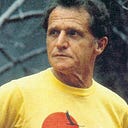The Finest Day for the New Zealand Athletics
Sept. 2, 2020 — It was 60 years ago today (September 2nd, 1960) when everything Arthur Lydiard had done in the previous 15 years had paid off and the world made a notice of the fact that the athletic training revolution was under-way. The place was Rome, Italy, at Stadio Olympico, the site of the 17th Olympic Games. Early in the evening, they had men’s 800m final. In the field was a 21-year-old complete unknown from down-under in the New Zealand’s traditional All-Black uniform with Silver Fern on the chest, Peter Snell. He was ranked #25th in the world at that point. Nobody expected him to even advance to the final— then the leading athletic shoe manufacturer, adidas, went around and giving away their top-of-the-model spike shoes leading up to the final. Snell was the only one in the final who didn’t receive a pair. So Snell wore hand-made spike shoes by his coach, Arthur Lydiard. Going into the final turn, Snell was seemingly boxed inside lane. As then the world record holder, Roger Moens led into the straight, the runners spread wide and now Snell had the opening. In the thrilling “dive” to the tape, Snell nipped Moens by a couple of inches (watch the race HERE). Now unknown novice became the first gold medalist in the Track & Field event for New Zealand since 1936 Berlin Olympic Games (Jack Lovelock for 1500m). Along with his coach, Arthur Lydiard on the stand, there was Murray Halberg at the athletes waiting room, getting ready for the next event on the track a half an hour later, men’s 5,000m final, thinking: “Now it’s my turn…”
Ten years earlier, a young Murray Halberg had a fatal accident during a rugby game and, literally, almost lost his life. He broke his left shoulder and now he could hardly move his left arm. It just sort of “hang” when he ran. He not only survived but excelled in athletics — middle and long distance events. In Rome, Halberg and Coach Lydiard set up a race strategy of sprinting out 3-laps to go and hang in there for his dear life. Three laps to go, he threw a 60-second lap and took a 30-yard lead on the rest of the field. In the final lap, German’s Grodotzki and Poland’s Zimny closed the gap but Halberg had enough to spare and “hang in there” till the finish. Murray Halberg was second to the last in the final of 1,500m in 1956 Olympic Games 4 years earlier. He was devastated and thought about quitting running all together. But when he decided to “hang in there”, he was determined to come back to the Olympic stadium, not just as a contender, but as a “champion”. He did. After crossing the finish line, Halberg collapsed infield more probably because of the relief of the nervous tension (watch the race HERE). From death-bed to the top of the Olympic podium…this was one of the bravest footraces ever. Lydiard used to say that Murray Halberg is probably the runner he respected most — overcoming physical handicap and “hang in there”.
One week later on September 10th, Barry Magee won the bronze medal in the marathon to “complete the mission” as Barry would put it. Tiny island country of New Zealand, many European spectators at Stadio Olympico didn’t even know where New Zealand was, with population of mere 3-million (at that time) won two Olympic gold medals within an hour on September 2nd; and went on and won another medal (bronze) a week later. And they were all coached by the same guy — Arthur Lydiard. This was the beginning of the Lydiard Legacy… — Nobby Hashizume
